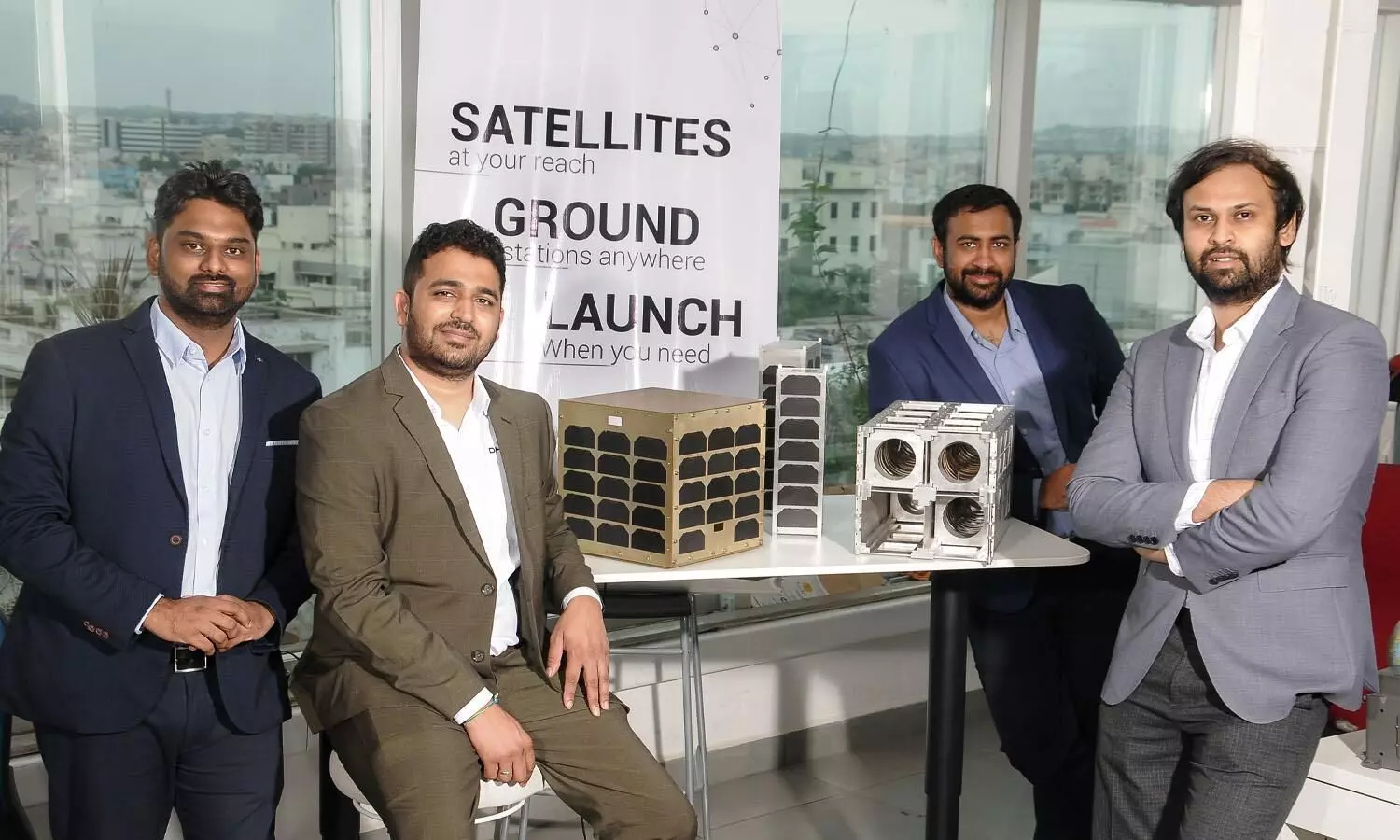INTERVIEW: Ebullient Dhruva plans 10-30 kg satellites in near future, can go till 300 kg
Dhruva Space, founded in 2010 by four college buddies, is India's first private space start-up

HYDERABAD : Hyderabad-based space technology startup Dhruva Space has been making headlines since Indian Space Research Organisation (ISRO's) PSLV-54 launched the EOS-06 satellite and eight nanosatellites into different SSPOs. The mission was accomplished by Satish Dhawan Space Center (SHAR) on November 26, 2022.
Eight nanosatellites, including the two satellites Thybolt 1 and Thybolt 2, created by Dhruva Space, are currently in good health, operating properly, and broadcasting data throughout the globe.
Dhruva Space, founded in 2012 by four college buddies, is India's first private space start-up. In an exclusive interview with NewsTAP, the founders discuss Dhruva's Space's inception, the Thybolt mission, and their future plans to make India the world's satellite capital.
How does it feel to be the first Indian private company to secure an order for the end-to-end design and development of Space-grade solar arrays?'''
It feels nothing short of fantastic. Dhruva's vision has always wanted build things in India for the world. Securing this contract reinforces our vision and paves way to be part of the global space economy— Vishal Latha Balakumar, Mission Specialist.
What inspired the establishment of Dhruva Space? Give us details of the hurdles and undeterred perseverance in your decade-long journey before you tasted success.
Background info: Since its inception in November 2012 as the first private Indian space-tech company, Dhruva Space Private Limited has seen a remarkable evolution over the years. Having crossed paths during college days or during their early professional years, longtime friends Sanjay Nekkanti, Chaitanya Dora Surapureddy, Abhay Egoor and Krishna Teja Penamakuru are the co-founders of Dhruva Space.
Nekkanti built his first satellite during SRM University's SRMSAT project in 2011. Following this, he pursued a dual-degree Master's programme in Space Engineering in Europe. Upon his return to India, Nekkanti was determined to establish India as a satellite-making capital of the world. In 2012, Dhruva Space Private Limited was founded with this in mind.
In 2018-19, through a separate consultancy endeavour for Thybolt, an electronic design lab based in Hyderabad, Nekkanti reconnected with Abhay Egoor, Krishna Teja Penamakuru, and Chaitanya Dora Surapureddy. Having seen how there were no private space-tech manufacturers, the four friends and collaborators were determined to create the first Indian-made satellite and to launch it from Indian ground. This paved the way for Thybolt to be absorbed into Dhruva Space for a new chapter in the space company's growth. You will see that this explains the nomenclature of the Thybolt Mission.
Before successfully establishing contact with both satellites after they were injected into orbits, and before seeing the performance of the in-house-developed subsystems is normal, how did you feel? What do you feel about this landmark achievement?
"We are so proud of the team who worked hard on various aspects – hardware, software, project management, and more – of the Thybolt Mission. When we saw that successful ejection of the two satellites had been successful, we were absolutely elated; that recorded moment of our reactions has been circulated on our social media platforms. But the mission is not over at that point; we had to ensure that the P-DoT satellite platform and its subsystems have been successfully Space-qualified through reception of data. And given this is a mission dedicated to the amateur radio operators, we also had to ensure successful amateur radio store-and-forward payload operations, which we are already seeing pour in!" –Krishna Teja Penamakuru, Chief Operating Officer
How did you impress the client that you are competent to handle this?'''
As it is a public procurement process, we cannot divulge on the details. All we can say is that the client has evaluated the proposal on both technical and financial merits— Vishal Latha Balakumar, Mission Specialist.
Could you please explain the operation of Thybolt-1 and Thybolt-2?
"These are two satellites of the nanosatellite-class, each one weighing less than 750 grams. The Thybolt satellites are developed on our indigenously-developed P-DoT satellite platform. These 0.5U satellites are built to enable many more amateur radio enthusiasts to perform certain radio activities when the satellites are orbiting around the Earth." – Abhay Egoor, Chief Technology Officer
"As a full-stack Space-Engineering solutions company, we undertake the three essential aspects of any Space mission: Space, Launch and Ground. On the Space side, we will be testing our satellites; on the Launch side, we will use our Dhruva Space Satellite Orbital Deployer (which puts the satellites into orbit) which we qualified onboard PSLV C53; and on the Ground side, we will operate the satellites. So in the Thybolt Mission, we've done a 'full-stack' mission." – Sanjay Nekkanti, Chief Executive Officer.
Did you receive any data transmitted from Thybolts-1 and Thybolt- 2?
"I am very happy to share with you that the mission performance has been outstanding. It's overwhelming to see data from both the satellites coming in from all over the world. Beacon data is being heard somewhere over the EU. (What you hear is the Morse code transmission of the data being received) We have decoded the same and it indicates that both the satellites are healthy and working normally. Over the next few weeks the Dhruva Space teams shall continue working on evaluating other mission objectives and we shall keep the community posted." – Abhay Egoor, Chief Technology Officer
What are you working on next after the successful launch of Thybolt-1 and Thybolt-2? Are you planning bigger satellites?
Typically, it is assumed satellites are the size of a bus or a trailer, but we are seeing more demand for smaller satellites. Dhruva Space builds small satellite platforms and subsystems of various classes, from 0.5-kilogram to up to 300-kilogram class. We have plans to launch these other satellites – such as our P30 platform which can weigh between 10 and 30 kg – in the near future.
What factors are contributing to the increased participation of private firms in the space sector?
"For a long time, India's space industry was State- or Government-run; now, we observe the Government of India empowering the privatization of the Sector. There are three factors contributing to the growth in participation of private firms in the space sector: policy, access to capital and growth in the general ecosystem to serve markets outside of India. All this is fuelled by the tremendous growth of requirements for satellites globally. A key to commercial success in the Space industry is the flight heritage of the systems. It helps that India is known for its thriving IT industry and its Space programme, the latter for which 400 assemblies have demonstrated active and continual support over the last five to six decades. The current Government has been very forthcoming in bringing about an interesting revolution where private players experience a level playing field in trying to support not just local requirements but also global requirements too.
In addition to this, it is interesting to see that according to the Economic Survey 2021-22, there are 101 private startups in this Sector. Dhruva Space, having been founded in 2012, is India's first private space startup; now there are 50-plus private startups in India. If you look at the infusion of capital into the Private Space Sector from 2012 till now, it comes to US$50-60 million and this figure will increase, signalling that investors are interested. Space being very close to Defence, the Government has a lot of push power towards Make-in-India which is all adding up to people foraying into this Sector.
The timing of the vitalisation of the Private Space Sector has been integral, considering there are many small satellite requirements globally. The projections are estimated to be in the tens of thousands in number; in order to meet any of those demands, the global supply chain needs to be robust and strong. These startups that exist in the ecosystem along with 400-odd companies that build small components for the Indian Space Programme are gearing up to benefit from this sudden 'Space Rush'.
All three of these factors work symbiotically. We are already seeing private companies raising substantial capital, leveraging a greater degree of autonomy in making decisions while working with regulatory bodies such as IN-SPACe to maintain a certain level of accountability, and engaging the public in a more detailed dialogue around Space and Satellite Technologies. Such support will inexorably boost participation not just across startups but also investors and stakeholders, as well as progressive collaborations." – Sanjay Nekkanti, CEO.
What is the current headcount in Dhruva Space? Do you plan to expand?
"We are currently a team of about 50 members – a mix of engineers and business development executives. But we are certainly planning to scale up our team. We are also looking at setting up a manufacturing unit in Hyderabad for our products." – Chaitanya Dora Surapureddy, Chief Financial Officer
Are you scouting for new projects abroad? Who are the biggest clients in the pipeline?
While we have ongoing projects with our existing partners across India and the world, we are also looking to foster new collaborations that create more Space missions while further establishing India as a Space Nation." – Abhay Egoor, CTO



